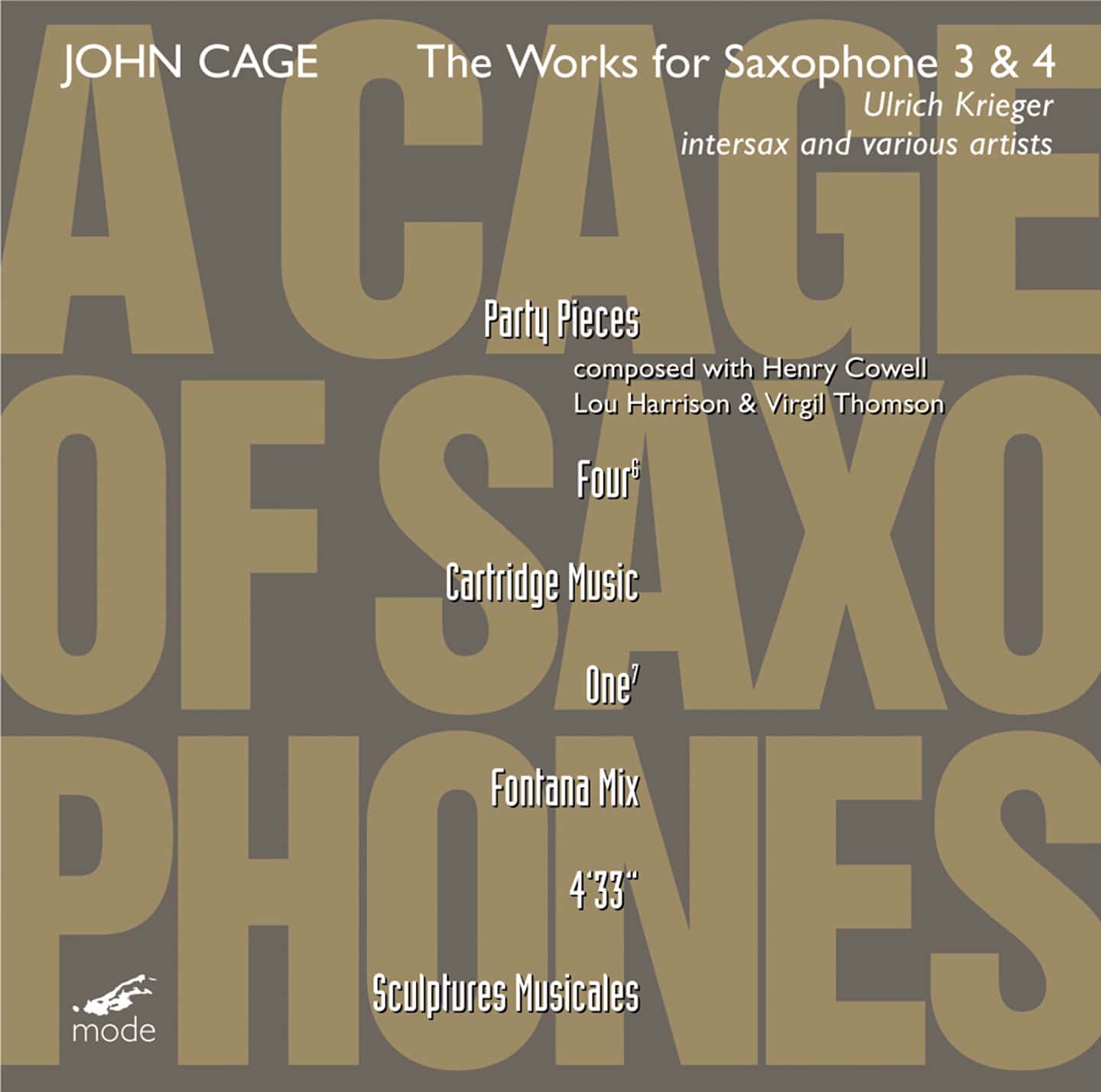Cage Edition 42-A Cage of Saxophones 3 & 4
The 1st work for amplified saxophone quartet; the 2nd work for soprano, alto, tenor, and baritone saxophones, violin, viola, violoncello, contrabass, accordion, piano and percussion; the 3rd work for bass-flute, contrabass-flute, bass-clarinet, contrabass-clarinet, bass-saxophone, and contrabass-saxophone; the 4th work a version for electronics; the 5th work an arrangement for saxophone quartet; The 6th work for solo saxophone(s), one performer (sopranino, soprano, alto, tenor, baritone, and toy saxophones); the 7th, 9th works for saxophone trio; the 8rd work for sax, clarinet, bass-clarinet, accordion, percussion, piano, violin, viola, violoncello, didjeridu, various wind instruments, amplified objects, and electronics. (viewed Feb. 7, 2013). Intersax ; Ulrich Krieger, artistic director, saxophones and instruments ; and other musicians. Recorded 2003-2005 at RBB Berlin and Pi-Farm. Previously released as a compact disc.
John Cage: A CAGE OF SAXOPHONES VOLS. 3 & 4 – Indeterminancy
Party Pieces (1944/45) (10:10)
composed with Henry Cowell, Lou Harrison and Virgil Thomson arrangement for saxophone quartet
Four6 (1992) (20:20)
version for amplified saxophone quartet
Cartridge Music (1960)
Eleven Instruments (2005)
instrumental version for: 4 saxes, violin, viola, cello, bass, accordion, piano, percussion
Fontana Mix (1958) (10:00)
Sextet for low woodwinds (2005) (15:00)
instrumental version for: bass-flute, contra-bass flute, bass-clarinet, contrabass-clarinet, bass-saxophone, contrabass-saxophone
Fontana Mix (1958) (10:00)
electronic version (2004), derived from the pieces recorded on a “Cage of Saxophones, Vols. 1-3”
One7 (1992) (30:00)
version for solo saxophone(s): sopranino, soprano, alto, tenor, baritone & toy saxophones (one performer)
4’33” (1952) [open windows version] (4:33)
version for saxophone trio
4’33” (1952) [studio version] (4:52)
version for saxophone trio
Sculptures Musicales (1989) (37:01)
version for sax, clarinet, bass-clarinet, accordion, percussion, piano, violin, viola, cello, didjeridu, various wind instruments, amplified objects, electronics
Ulrich Krieger, artistic director, saxophones & instruments
Intersax
and other musicians
Ulrich Krieger completes his A Cage of Saxophones survey of Cage’s works composed for, or which can be played on any instrument or instruments.
For this volume, Krieger combines works specifically composed for saxophone with works of no specified instrumentation that are suited for saxophones and winds.
Most of these are “indeterminate”works, which require the performer to create the realization based on materials supplied by Cage. In some situations, Krieger used Cage’s compositional “tools” to create his own parallel works.
The set includes the only available recording of “Party Pieces”, composed in collaboration with Henry Cowell, Lou Harrison and Virgil Thomson. In “Party Pieces”, one composer would write a bar of music plus two notes, folded the paper at the bar, passing it to the next composer, who would use the two notes as a base for continuing the composition. Composed for any melody or keyboard instruments, Krieger has made a realization for saxophone quartet.
Reviews
Cage, John
The Works for Saxophone 3 & 4: Party Pieces / Four6 / Cartridge Music / One7 / Fontana Mix / 4’33” / Sculptures Musicales
Interpret: Ulrich Krieger, Saxofone und andere Instrumente;
Intersax u. a.
Verlag/Label: mode records, mode 222/23
Rubrik: CDs
erschienen in: Neue Zeitschrift für Musik 03/2011, Seite 90
Musikalische Wertung: 5
Technische Wertung: 5
Repertoirewert: 4
Booklet: 5
Gesamtwertung: 5
Mit einer Doppelausgabe bringt Ulrich Krieger seinen «CAGE of saxophones» zu einem rundum gelungenem Abschluss. Dass dies im letzten Kapitel besonders gut funktioniert, hat nicht allein mit den flexiblen Vorgaben von John Cage zu tun, sondern viel damit, wie der umtriebige Saxofonist, Klangkünstler, Komponist und Improvisator mit seinem Instrument umgeht, was herzlich wenig mit dem zu tun hat, wie wir das Saxofon normalerweise wahrnehmen.
Schon Four6 (1992), hier mit verstärktem Quartett eingespielt, offenbart die Fruchtbarkeit von Kriegers Konzept einer «acustic electronic», die auf beeindruckende Weise pseudo-elektronische Klangeindrücke mit konventionellen Instrumenten erzeugt. So entsteht (ebenso wie in One7, wo Krieger sechs verschiedene Saxofone selbst spielt) eine wunderbar kontemplative Version mit schwebenden Klangflächen und feinen Geräuschnuancen, die atmosphärisch dichte, ja schlichtweg schöne Manifestationen des Augenblicks generiert.
Ein ganzes Kammermusikensemble lässt Krieger in seiner Auffassung der Cartridge Music (1960) zum Einsatz kommen, deren Klangerzeuger normalerweise Tonabnehmer von Schallplattenspielern darstellen. Das provoziert jedoch auch hier kein plapperndes Musikantentum, sondern eine in sich ruhende «Musique concrète instrumentale», die als gelassene Geräusch-Collage daherkommt. Asketische Reduktion auch beim ursprünglich elektronischen Fontana Mix (1958), das Krieger als «Tool» für ein tiefes Holzbläsersextett benutzt – ein Netzwerk sanft irisierender Liegeklänge. Aber auch in seiner ursprünglichen Idee als Band-Musik taucht Fontana Mix auf: Krieger nahm einfach das Material aller bisher produzierten CDs seiner Cage-Reihe und mischte daraus einen wuseligen Remix. Der fällt hier ebenso aus dem Rahmen statischer Klang-Kontemplation wie die Party Pieces (1949/59), die Cage aus einer kollektiven Noten-Schnipselei mit Henry Cowell, Lou Harrison und Virgil Thomson gewann – zwanzig ausgesprochen melodische, leicht verdauliche «Party-Häppchen» mit jazzigem Beigeschmack.
Der Kontrast könnte nicht größer sein zu den rauen Oberflächen der Sculptures Musicale (1989), hier als erstaunlich homogene Interaktion aus zahlreichen Instrumenten, Realgeräusch und elektronischen Klangquellen eingespielt. Interessant ist auch Kriegers Sicht auf Cages legendäres 4’33” (1952), das hier in zwei von prinzipiell unendlichen Erscheinungsformen auftaucht: eine «open windows version», die erwartungsgemäß den Fokus auf Alltagsgeräusche wie Stimmen, Verkehr, Arbeitslärm etc. lenkt, und eine «studio version», die abgesehen von minimalen Bewegungsgeräuschen der regungslosen Akteure totenstill ist. So wird Version 2 zwangsläufig zu derjenigen des Rezipienten, mit den Klängen der Lebenswelt im Augenblick des Hörens: in diesem Fall kam Elstern eine tragende Rolle zu …
— Dirk Wieschollek, Neue Zeitschrift für Musik, March 2011
Links
John CAGE
A Cage of Saxophones 1 — Five; Ryoanji; Four5; Five4; Hymnkus (mode 104)
A Cage of Saxophones 2 — Sonata for 2 Voices; Atlas Eclipticalis; Two; Composition for 3 Voices; Solo for Baritone Sax; other works (mode 160)
Ulrich Krieger on Mode:
Luciano Berio: The Complete Sequenzas and Works for Solo Instruments (mode 161-163)
Gavin Bryars: The Marvellous Aphorisms of Gavin Bryars: The Early Years (mode 177)
John Cage: A Cage of Saxophones, Volume 1 (mode 104)
John Cage: A Cage of Saxophones, Volume 2 (mode 160)
John Cage: A Cage of Saxophones, Volumes 3 & 4 (mode 222/223)
Ulrich Krieger: [urban dreamings] (mode 280)

